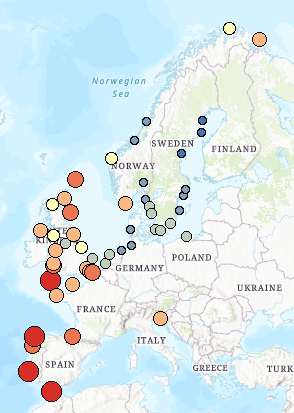Natural risk zones
Type of resources
Available actions
Topics
INSPIRE themes
Keywords
Contact for the resource
Provided by
Years
Formats
Representation types
Update frequencies
status
Service types
Scale
Resolution
-
View service for Earthquakes in Denmark
-
View service for Earthquakes in Denmark
-
Download service for Earthquakes in Denmark
-
National database on earthquakes in Denmark comprising information on time, position, depth and magnitude on Richter scale. The database is accessible on the GEUS website and is updated on an ongoing basis.
-

The gridded dataset presents the average forest fire danger in the present climate for the period 1981-2010 in Europe. The forest fire danger is expressed by the average Seasonal Severity Rating index (derived from the Canadian Fire Weather Index System), provided by the Joint Research Centre. The SSR series was computed usign the GCM-RCM run KNMI-RACMO2-ECHAM5 of ENSEMBLES project. The dataset contributes to the EEA indicator "Forest fires": https://www.eea.europa.eu/data-and-maps/indicators/forest-fire-danger-2/assessment
-

This vector dataset presents the extent of areas in European countries directly affected by wildfires (period 2000-2017). This dataset can be used as one of the indications where the danger of wildfires may persist or increase in the future under the changing climate. The dataset is one of the output of the “European Forest Fire Information System-EFFIS” (http://effis.jrc.ec.europa.eu) provided by the Joint Research Centre (JRC). The dataset is also part of the EEA indicator "Forest fires": https://www.eea.europa.eu/data-and-maps/indicators/forest-fire-danger-2/assessment.
-

The gridded dataset presents the forest fire danger in Europe for projected climate conditions under the Representative Concentration Pathways (RCP) 4.5 scenario for the temporal range 2071-2100. The forest fire danger is expressed by the average Seasonal Severity Rating index (derived from the Canadian Fire Weather Index System), provided by the Joint Research Centre. The SSR series was computed usign the GCM-RCM run KNMI-RACMO2-ECHAM5 of ENSEMBLES project. Average 2071-2100 SSR levels are provided in the dataset. The dataset contributes to an earlier version of the EEA indicator "Forest fires": https://www.eea.europa.eu/data-and-maps/indicators/forest-fire-danger-2/assessment.
-

The raster dataset (grid 0.25° x 0.25°) presents the trends in frequency of meteorological droughts between 1950 and 2012. Trends are based on a combination of three different drought indices - SPI (Standard Precipitation Index), SPEI (Standardized Preciptation Evapotranspiration Index) and RDI (Reconnaisance Drought Index) accumulated over 12-month periods. The dataset contributes to an earlier version of the EEA indicator "Meteorological and hydrological droughts": https://www.eea.europa.eu/data-and-maps/indicators/river-flow-drought-2/assessment
-

This dataset presents the estimated multiplication factor by which the frequency of flooding events of a given height in European tide gauges will change between 2010 and 2100, due to projected regional sea relative level rise under the Representative Concentration Pathways (RCP) 4.5 scenario. Values larger than 1 indicate an increase in flooding frequency. This dataset is derived from the Figure 13.25(b) of the Working Group I contribution to the IPCC Fifth Assessment Report (http://www.climatechange2013.org/images/report/WG1AR5_ALL_FINAL.pdf). This dataset also contributes to an earlier version of the EEA Indicator "Global and European sea-level": https://www.eea.europa.eu/data-and-maps/indicators/sea-level-rise-5/assessment.
-

The EEA potential flood prone area extent delineates the area that is flooded once every 100 years, i.e. the probability of flooding is 1% assuming that flooding is unrestricted. The potential flood prone area is comprised of the river channel and floodplain. In reality, the floodplain is split into an active floodplain where flooding still occurs, and former floodplain where flooding is restricted due to flood protection. The former floodplain could be flooded again either if a flood exceeds the capacity of flood protection, or if factors that control the presence of water were removed. These factors include channel and floodplain morphological alterations as well as structural flood protection measures. The spatial coverage of the data set is EEA39 countries.
 RUC Geo-Data catalogue
RUC Geo-Data catalogue